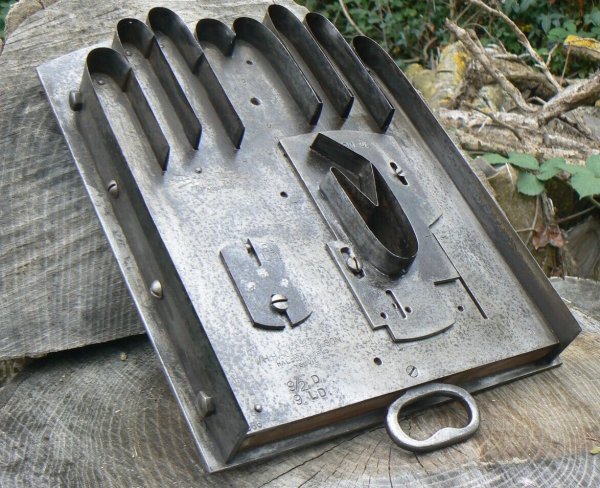The Gloving WEB
The Gloving WEB
A die cutter used to stamp out glove blanks
The following description of the gloving web, is courtesy of David Shore.
"I served my apprenticeship at W H Hallett & Son, Hallson Works, Sherborne Road, in the mid 1950s.
The Web, as we called it, was constructed on a 1/4" thick steel back-plate. There was a wood spacer topped with a No 14 gauge thick face plate. The cutters were made from "high carbon knife steel" forged into shape in a blacksmith's forge and shaped using zinc templates. They were then heated red hot in the forge and quenched in whale oil. The hardened blades were then slowly reheated until the whale oil on the blade caught alight in the flame - this indicated the temperature for tempering was reached and then the blade was finally quenched.
Once all the knives were assembled in the 'Web', the cutting face of the knives were levelled on a large sanding disk. The whole assembly was then dismantled and each knife was brought up to edge on grinding wheels running up and away from you. The grinding wheels were made from wood with a strip of leather stuck around it with animal glue and little oak pegs. The leather was then painted with more hot animal glue and rolled in Emery grit. The grinder was quite noisy so we learnt to lip read. I remember the leather once coming unstuck and a knife blade was flung through Mr Hallett's overhead office wall.
Once the blades
were brought up
to edge they
were finally
honed with oiled
Arkansas stone.
There was also a
Bolton opening
for the thumb
which was
adjustable. The
back plate was
radiused all
round and then
draw filed and
polished and
buffed to look
like chrome and
the face plate
was screwed to
the back plate
with 3BA
countersunk
screws and their
heads were
polished and
buffed to look
like chrome. We
also made Thumb
punches that
were formed from
the same knife
steel."
GALLERY

A die cutter, or Web, used to stamp leather glove blanks.